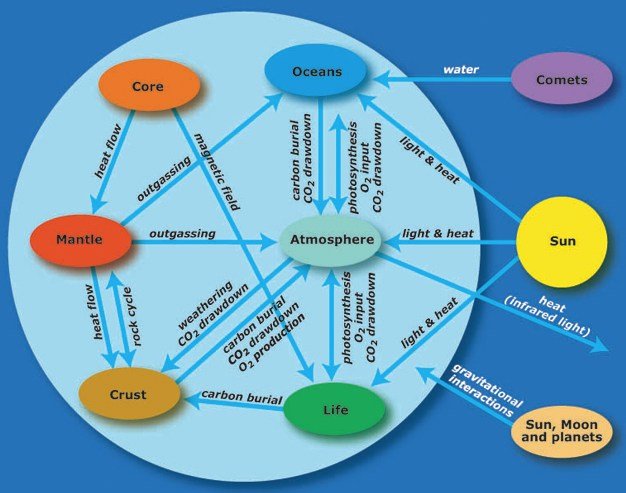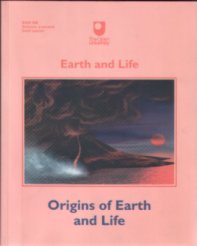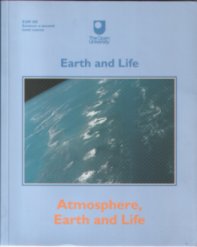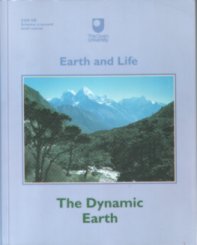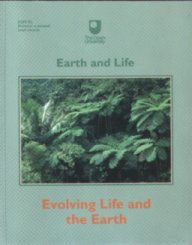
S269 Earth and Life
S269 diary - Block 1
Block 2
Block 3
Summaries:
Block 1
Block 2
Block 3
Block 4
OU S269 Course Description
Study Guide 1
Study Guide 2
Study Guide 3
Study Guide 4
OU Earth Sciences
John Macadam's Website
The Ross Ice Shelf.
Radiocarbon Dating (University of Waikato, New Zealand)
Radiocarbon Dating (University of Santa Barbara, California, USA)
Physical Geography.net (Okanagan University College, Canada)
Physical Geography.net - Periglacial Processes and Landforms
Canadian Ministry of Agriculture
Climate change 2001: The Scientific Basis
CEFAS - The Centre for Environment Fisheries and Aquaculture Science - Fish Stock Management - Depth Contours
Monte Verde Excavation: or Clovis Police Beat a Retreat
Burren farming in the Neolithic
The Permian-Triassic Mass Extinction
Paleo Maps Project
Nasa Planetary Photojourney
Berkeley University Virtual Paleobotany Lab
David Scarboro's Tutor Website
Useful Websites for S269
(including)
Beagle 2
Martian Meteorites, and the search for life on Mars (NHM article)
The Plates Project
Origins
SeaWiFS Project
West's Geology Resources
Geological Sites for Tourists
Hilma's Croll-Milankovitch Cycles and Climate Change
Tutors' Views on S269
Students' Views on S269
(other relevant links can also be found on my S260 and S103 pages.
Back to OU
TMA Scores
TMA01 77%
TMA02 78%
TMA03 79%
TMA04 38% (I only did half)
Exam: 11th October 2004 at 10:00-13:00
15th December 2004
Extremely pleased and somewhat shellshocked (as I had been quite sure I'd failed!) to get my result today and a Grade 2 pass!! Heck, even the examiners must've realised what a stinker the exam was then, because they really must've lowered the grade marks!!
HAPPY, HAPPY, HAPPY!!!
14th October 2004
Well, the exam was on Monday.
O
M
G!
I worked darned hard on the revision, but the questions were about totally different things!
But IT'S OVER - thank goodness!
1st December 2003
The first mailing arrived today - so I guess it's time to get started!
Some say that this course is as hard as a 3rd level one - but I really want to do it. Of all the earth science ones on offer; this is the one I find the most appealing - and I have registered to do it from February 2004!
Summary
Over three billion years life has evolved in response to its environment, and in so doing has progressively changed that environment. Current environmental debates concerning global climatic change raise complex issues that can be answered only from an informed geological perspective. This course will enable you to develop your own opinions. From the origin of the Earth and of life we examine the Earth's climate and atmosphere before looking at organic evolution, global ‘ice-houses' and ‘greenhouses.' Finally, with text on the website, we examine the rapid interactions between Earth and life over the last 10,000 years.
Possible Model of Earth System (from course website)
26th July 2003
A friend has kindly lent me her coursebooks, so that I can look and see (and read too!)
1
What is life?
The search for life on Mars
Living or non-living?
Life and rthe chemical elements
Stars and alchemy, planets and life
The airship and the hydrogen bomb
Our Sun - a helium factory
Making the heavier elements
The stuff of life
Other heavier elements
Hydrogen - the sine qua non
The cosmic cycle
Secondhand elements
The cosmic abundance of the elements
From interstellar dust to planets
Interstellar dust
Interstellar chemicals
An idea of the Marquis de Laplace
Formation of the planets
The Oort cloud and the Kuiper belt
The early Earth - conditions for life?
The story in the oldest rocks
Structure of the early Earth
Early plate tectonics?
An interim summary
Geological evidence of the origin of life
Stromatolites
Carbon isotopes
Earth's cratering record
The Moon
The story of the lunar craters
A glimpse of the early Earth
The Hadean Earth
Early atmosphere and hydrosphere
Hadean climate and weather
The window of opportunity
Life and the chemical elements revisited
Theories on the origins of life
Ear;y extraterrestrial theories
Chemical theories
Life's information superhighway
Building blocks of life
'Warm little ponds'
Hydrothermal vents
Space invaders
Making larger molecules
Origins of genetics - chicken or egg?
Microbes from mars
The long haul begins
From fermentation to respiration
The Earth System and its cycles
2
Oxygen and the Earth
How much oxygen is there?
Oxygen and life
The rold of oxygen - an overview
Reactivity of oxygen
Respiration and the Earth's oxygen inventory
Photosynthesis and the Earth's oxygen inventory
Critical questions and a plan of campaign
The fossil record
Looking backwards through time
Interpreting the fossil record
The first land animals
The first land plants
The earliest animals and algae
The first photosynthesizers
Photosynthesis and the carbon isotopic record
How much life? - quantifying the fossil record
The rock record
Evidence from iron-bearing deposits
Characteristics of iron in the rock record
REd beds
Banded iron formations
Paleosols
Evidence from uranium deposits
Inference from mantle oxidation
Looking back to the very beginning
A synthesis
Evolution of the Earth's atmosphere during the Cryptozoic
Early atmospheres
Primary atmospheres
Secondary atmospheres
Formation of the Earth's secondary atmosphere
Non-photoynthetic oxygen
The early atmospheric cycles
Oxygen levels in the Proterozoic
Modelling the evolution of atmospheric oxygen levels during the Phanerozoic
Using models
The Berner and Canfield model
Results of the Berner and Canfield model
Results of the Berner and Canfield model
The late Paleozoic oxygen peak: some implications for life
A closer look at the regulation of atmospheric oxygen
Do fires really regulate atmospheric oxygen?
The role of phosphorus
Forest fires and phosphorus?
Modelling the oxygen-phosphorus link
Ozone and life
Oxygen, ozone and short-wavelength radiation
Ozone, climate and atmospheric circulation
Evidence of ozone in the rock record?
Carbon dioxide and the Earth
Divergent paths
Plan of action
An empirical model of atmospheric carbon dioxide levels during the Cryptozoic
Some propositions about the Hadean Earth
Setting some limits for the Hadean: the maximum atmospheric CO2 level
The minimum atmospheric CO2 level: the planetary energy balance equation
The change in the level of CO2 over time
Changes in effective temperature
The Archean climate
The Proterozoic: heat waves and glaciers
Energy Blanace model for atmospheric CO2
Examining the assumptions in the Energy Balance model
Introduction
The carbon dioxide-global temperature link
The Earth's albedo
Other greenhouse gases
Checking the independent evidence
Ultimate causes for the decline in atmospheric CO2
A process-based model of atmospheric carbon dioxide levels during the Phanerozoic
Introduction
The major sources and sinks of CO2 to the atmosphere
Some propositions about the Phanerozoic Earth
Assembling the data and building a model
The date
The GEOCARB model
Estimating the controlling priocesses
Volcanism
Weathering of silicates
Weathering feedbacks
Sedimentation and burial
Shift of carbonate precipitation from shallow shelves to deep oceans
Bringing the data together
The controlling processes
Sensitivity analysis
Evaluatuing the evidence
Paleosols
Hungry leaves
Fussy plankton
Plaeoclimate indicators
Comparing the Energy Balance and GEOCARB models
An overview - the Earth's atmosphere in a lifeless world
The fate of oxygen in a lifeless world
The fate of carbon dioxide in a lifeless world
3
An hospitable planet
How is the Earth different?
Energy from the Sun
Keeping the Earth habitable
The distribution of temperature over the Earth's surface
The Earth's air-conditioning and heating systems
Transport of heat and water by the atmosphere
Heat transport by the ocean
Atmosphere-ocean coupling
The deep circulation
A closer look at climate
The atmosphere - bringing in chemistry
Atmosphere-ocean-Earth: the support system for life
Sunspots and climatic change: the importance of keeping an open mind
The carbon cycle
Carbon and life
Carbon and climate
The natural carbon cycle: a question of time-scale
Short time-=scales: the terrestrial carbon cycle
Intermediate time-scales: the marine carbon cycle
A system in balance?
Short-circuiting the geological carbon cycle
Volcanism and the Earth system
Volcanic aerosols and climatic change
Climatic effects of the eruption of Mount Pinatubo
Historic eruptions
The Toba eruption
Flood basalts and their climatic effects
Lessons from the Laki Fissure eruption
Are flood basalts implicated in mass extinctions?
CO2 emissions from the Deccan Traps: did it cause greenhouse warming?
Taking a global view
Plate tectonics, carbon and climate
Continental drift and climate
Rearranging the continents
Continental drift, ocean currents and climate change
Glacial and interglacials
Sea-level change: causes and consequences
Contributions to sea-level changes
Causes of eustatic sea-level change
Sea-level, climate and atmospheric CO2
Tibet, the Himalayas and the Arabian Sea
Raising the roof of the world
Why are the Himalayas and Tibet so high?
When was the Tibetan Plateau uplifted?
The uplift of Tibet and climate change
Present-day climate
Evidence for climate change
The Himalayas, Tibet and atmospheric CO2
Strontium isotopes and the rate of chemical weathering
Cycles in the sediments: climate records in the Arabian Sea
4
The evolution of evolution
Former worlds
Empire of the eukaryotes
What is a eukaryote?
Eukaryotes and ecology
Eukaryote architecture and evoltion
The rules of the new evoltionary game
The rise and rise of the eukaryotes
The prelude - stromatolite world
Eukaryote beginnings
Diversification of the eukaryotes
The carnival of the animals
Ediacaran faunas
Interpreting the Ediacaran fossils
Feedbacks between the late Proterozoic Earth and life
The setting
Late Proterozoic geography
Climate
Why the ice ages?
Geographical factors
Some geochemical considerations
Modelling the feedbacks
Other factors?
Life's ups and downs in the Phanerozoic
Ediacaran decline and the spread of consumerism
The Proterozoic-Phanerozoic transition
Proterozoic Ragnarok?
The Cambrian explosion
New body-plans and new ecological horizons
Hunting the hunters
Ancestry of the Cambrian animals
A provisional synthesis
The feedback effects of the Cambrian explosion
Impact on the carbon cycle
The feedbacks of feeding
Radiations and extinctions
Estimating the turnover of life
Mass extinctions
Evolutionary radiations: opportunity knocks
Ecological relationships and their consequences
Greening of the land
The power house of the biosphere
Befoe the invasion by plants
An alien world
The land without plants
From ocean to land: making the change
Problem 1: the fight against gravity
Problem 2: bodily fluids
Problem 3: reproduction
Adaptations and consequences
How is water cycled through the atmosphere by vegetation?
The land turns green
Beginnings
Interpreting the structure of early land plants
The evolution of the leaf
The first forests
Green reflections
A closer look at climate
Climate today
How climate works
Zonal circulation and monsoons
Making models of ancient climates
Qualitative models of past climates
Quantitiative climate modelling
An icehouse case study
The setting
Geographical perspective
Geological evidence
Permo-Carboniferous glaciation and subsequent warming
The available record
The link between atmospheric CO2 vegetation and climate
Continental motion, collisions and climate
Extraterrestrial causes of climate change
The impact of land vegetation
Land plants in teh Carboniferous and Permian
Lepidodendron - a typical swamp dweller
The legacy of the forests
A synthesis for the icehouse
The terminal Permian mass extinction
Life at sea
Plate tectonics revisited
Another look at CO2 vegetation and climate
An extinction scenario
A greenhouse case study
Cretaceous geography
Polar climate
The case of Alaska
The Arctic forests
The cycad conundrum
A new perspectuve
Taking stock
Low-latitude vegetation and climate
Water supply
Qualitative and quantitative inferences
Quantifying climate reconstructions
Plants as thermometers
The problem with relatives
Following form
Model results
Life and conditions in the sea
Geographical framework
Tethyan carbonate platforms
Quantifying the growth of the platforms
Other sinks for carbon
A surfeit of carbon: the key to the Cretaceous greenhouse
De Profundis
The greenhouse atmosphere
Conclusion from the case studies
The relationship between evolving life and the Earth
Introduction
Possible worlds
Review of the options
Conclusion

